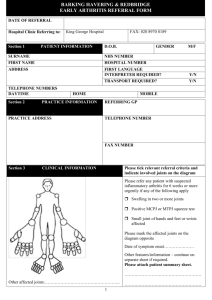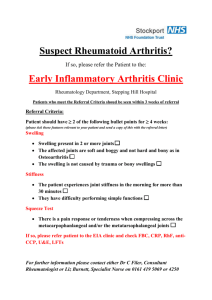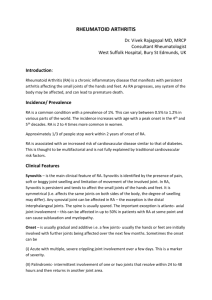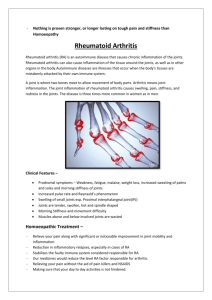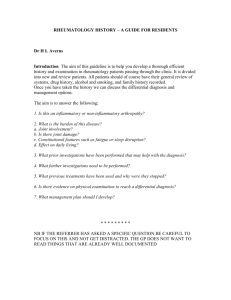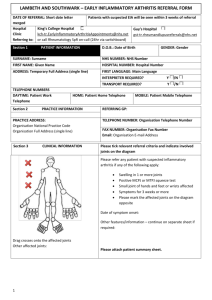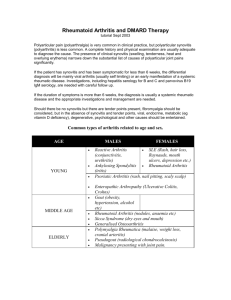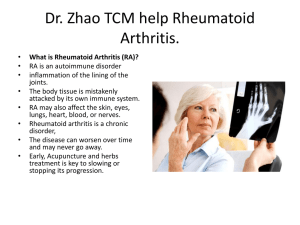Rheumatoid Arthritis Specification 2015
advertisement
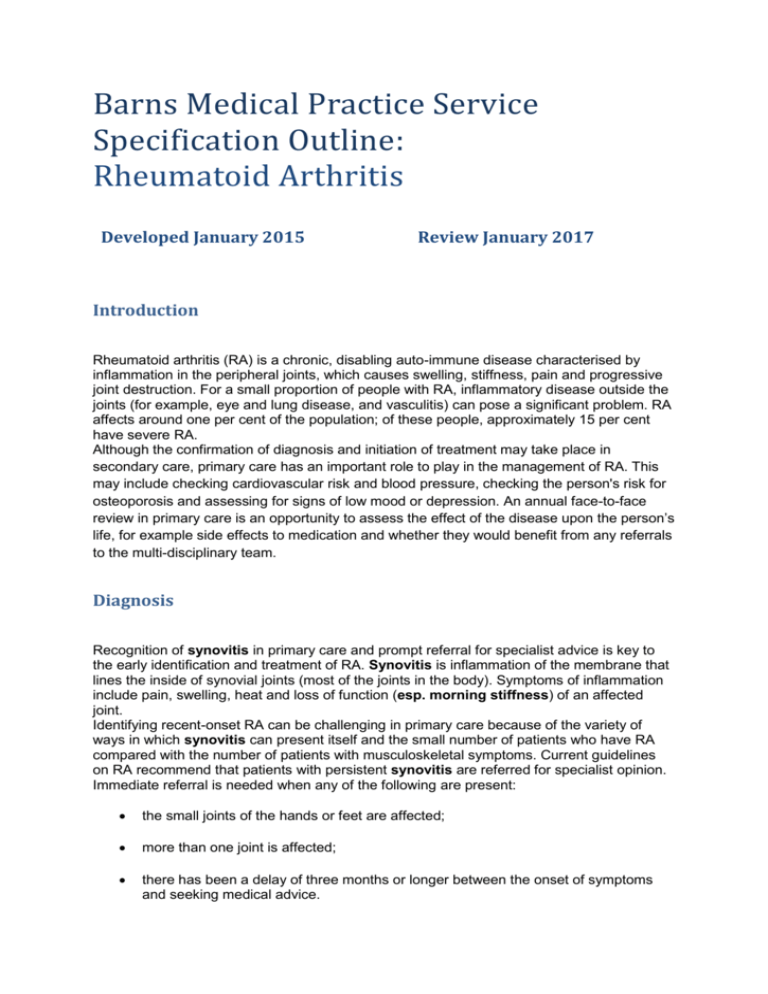
Barns Medical Practice Service Specification Outline: Rheumatoid Arthritis Developed January 2015 Review January 2017 Introduction Rheumatoid arthritis (RA) is a chronic, disabling auto-immune disease characterised by inflammation in the peripheral joints, which causes swelling, stiffness, pain and progressive joint destruction. For a small proportion of people with RA, inflammatory disease outside the joints (for example, eye and lung disease, and vasculitis) can pose a significant problem. RA affects around one per cent of the population; of these people, approximately 15 per cent have severe RA. Although the confirmation of diagnosis and initiation of treatment may take place in secondary care, primary care has an important role to play in the management of RA. This may include checking cardiovascular risk and blood pressure, checking the person's risk for osteoporosis and assessing for signs of low mood or depression. An annual face-to-face review in primary care is an opportunity to assess the effect of the disease upon the person’s life, for example side effects to medication and whether they would benefit from any referrals to the multi-disciplinary team. Diagnosis Recognition of synovitis in primary care and prompt referral for specialist advice is key to the early identification and treatment of RA. Synovitis is inflammation of the membrane that lines the inside of synovial joints (most of the joints in the body). Symptoms of inflammation include pain, swelling, heat and loss of function (esp. morning stiffness) of an affected joint. Identifying recent-onset RA can be challenging in primary care because of the variety of ways in which synovitis can present itself and the small number of patients who have RA compared with the number of patients with musculoskeletal symptoms. Current guidelines on RA recommend that patients with persistent synovitis are referred for specialist opinion. Immediate referral is needed when any of the following are present: the small joints of the hands or feet are affected; more than one joint is affected; there has been a delay of three months or longer between the onset of symptoms and seeking medical advice. Early identification of recent-onset RA is important because long-term outcomes are improved if diseases modifying anti-rheumatic drugs (DMARDs) are started within three months of the onset of symptoms. Blood tests should be done to confirm the clinical suspicion of RA in patients with synovitis and not as screening tests: Inflammatory Markers (including CRP and ESR) Rheumatoid Factor ANA-if features suggesting SLE and referral to Rheum OPD appropriate FBC U&E ; LFT Lipids-to be used in calculating CV risk scoring Regular Review RA is a chronic disease with a variable course over a long period of time. Therefore, there is a need for regular monitoring to determine disease status, assess severity, efficacy and toxicity of drug therapy and identify co-morbidities or complications. Patients with satisfactorily controlled established disease require review appointments for on-going drug monitoring, additional visits for disease flares and rapid access to specialist care. RA and its treatment can also have a negative effect upon a patient’s quality of life. It is recommended that the following aspects of care are reviewed regularly (at least annually) Disease activity and damage, which may include requesting CRP,ESR and FBC; Monitoring of DMARD’s as recommended in A&A protocols-Blood tests include FBC;U&E;LFT; urinalysis for some drugs Follow link below http://inps80081w2k3/Guidelines/Guideline%20for%20DMARD%20Monitoing.pdf The need for secondary care referral for review of drug therapy and/or surgery; The effect the disease is having on activities of daily living, eg. employment, education, home circumstances etc; Assessment of CV risk including BP, smoking history and lipids. (RA suffers have a similar CV risk as Type 2 Diabetes patients) Assessment of Osteoporosis risk Assessment of Depression risk Resources for Staff and or Patients Access to online resources including: Arthritis Research UK - http://www.arthritisresearchuk.org/ Patient information - http://www.arthritisresearchuk.org/ General Practice Notebook - http://www.gpnotebook.co.uk/homepage.cfm Staff involved and training required Trained clinicians, and HCA guided by appropriate protocols and assessment templates Advertising of service to patients Practice Website: Barns Medical Practice REFERENCES SIGN Guideline 123 Rheumatoid Arthritis Patient.co.uk-Rheumatoid Arthritis

